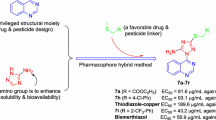Abstract
Isothiocyanates (ITCs) are one of the many classes of breakdown products of glucosinolates found in plants and exhibit biologic activity against various pathogens. In this work, aliphatic isothiocyanates were prepared and the antimicrobial activities against plant pathogenic fungi and bacteria were tested to understand the structure–activity relationships. The results indicated that longer-chain derivatives exert a steric inhibition on toxicity of ITCs against Rhizoctonia solani because of steric hindrance and the order of the eight aliphatic ITCs was ethyl > n-propyl > methyl > n-hexyl > n-octyl > n-butyl > n-heptyl > n-pentyl. Because the hydrophobicity of ITCs was enhanced by increasing alkyl chain length, the antibacterial activity of ITCs against Erwinia carotovora was moderately intense with an increase in hydrophobicity and the order was n-octyl > n-pentyl > n-heptyl > n-hexyl > n-propyl > n-butyl > methyl > ethyl. The present study revealed that some of the compounds exhibited promising antimicrobial activity and could be used as an acceptable alternative to the traditional synthetic fungicides for controlling R. solani and E. carotovora.

Similar content being viewed by others
References
Bennett RN, Wallgrove RM (1994) Secondary metabolites in plant defence mechanisms. New Phytol 127:617–633
Chuanphongpanich S, Phanichphant S, Bhuddasukh D, Suttajit M, Sirithunyalug B (2006) Bioactive glucosinolates and antioxidant properties of broccoli seeds cultivated in Thailand. Songklanakarin J Sci Technol 28:55–61
Cinciripini PM, Hecht SS, Henningfield JE, Manley MW, Kramer BS (1997) Tobacco addiction: implications for treatment and cancer prevention. J Natl Cancer Inst 89:1852–1867
Drewnowski A, Gomez-Carneros C (2000) Bitter taste, phytonutrients, and the consumer: a review. Am J Clin Nutr 72:1424–1435
Etzenhouser B, Hansch C, Kapur S, Selassie CD (2001) Mechanism of toxicity of esters of caffeic and dihydrocaffeic acids. Bioorg Med Chem 9:199–209
Fahey JW, Zalcmann AT, Talalay P (2001) The chemical diversity and distribution of glucosinolates and isothiocyanates among plants. Phytochemistry 56:5–51
Gamage GR, Park HJ, Kim KM (2009) Effectiveness of antimicrobial coated oriented polypropylene/polyethylene films in sprout packaging. Food Res Int 42:832–839
Jang M, Hong E, Kim GH (2010) Evaluation of antibacterial activity of 3-butenyl, 4-pentenyl, 2-phenylethyl, and benzyl isothiocyanate in brassica vegetables. J Food Sci 75:M412–M416
Kim MG, Lee HS (2009) Growth-inhibiting activities of phenethyl isothiocyanate and its derivatives against intestinal bacteria. J Food Sci 74:M467–M471
Kuroda K, Caputo GA, DeGrado WF (2009) The role of hydrophobicity in the antimicrobial and hemolytic activities of polymethacrylate derivatives. Chem Eur J 15:1123–1133
Kurt Ş, GÜneŞ U, Soylu EM (2011) In vitro and in vivo antifungal activity of synthetic pure isothiocyanates against Sclerotinia sclerotiorum. Pest Manage Sci 67:869–875
Li G, Tajima H, Ohtani T (1997) An improved procedure for the preparation of isothiocyanates from primary amines by using hydrogen peroxide as the dehydrosulfurization reagent. J Org Chem 62:4539–4540
Liblikas I, MÕttus E, Borg-Karlson AK, Kuusik S, Ojarand A, Kännaste A, Tanilsoo J (2003) Flea beetle (Coleoptera: Chrysomelidae) response to alkyl thiocyanates and alkyl isothiocyanates. Agron Res 1:175–184
Ma HX, Chen Y, Wang JX, Yu WY, Tang ZH, Chen CJ, Zhou MG (2009) Activity of carbendazim, dimethachlon, iprodione, procymidone and boscalid against Sclerotinia stem rot in Jiangsu Province of China. Phytoparasitica 37:421–429
Mochida K, Ogawa T (2008) Anti-influenza virus activity of extract of Japanese wasabi leaves discarded in summer. J Sci Food Agric 88:1704–1708
Mohn T, Cutting B, Ernst B, Hamburger M (2007) Extraction and analysis of intact glucosinolates-A validated pressurized liquid extraction/liquid chromatography-mass spectrometry protocol for Isatis tinctoria, and qualitative analysis of other cruciferous plants. J Chromatogr A 1166:142–151
Mueller DS, Dorrance AE, Derksen RC, Ozkan E, Kurle JE, Grau CR, Gaska JM, Hartman GL, Bradley CA, Pedersen WL (2002) Efficacy of fungicides on Sclerotinia sclerotiorum and their potential for control of sclerotinia stem rot on soybean. Plant Dis 86:26–31
Saksena NK (1985) Fungicidal action and structure correlation of monosubstituted phenyl isothiocyanates. Folia Microbiol 30:359–362
Schultz TW, Yarbrough JW, Pilkington TB (2007) Aquatic toxicity and abiotic thiol reactivity of aliphatic isothiocyanates: effects of alkyl-size and -shape. Environ Toxicol Pharmacol 23:10–17
Screnci D, McKeage MJ, Galettis P, Hambley TW, Palmer BD, Baguley BC (2000) Relationships between hydrophobicity, reactivity, accumulation and peripheral nerve toxicity of a series of platinum drugs. Br J Cancer 82:966–972
Smolinska U, Horbowicz M (1999) Fungicidal activity of volatiles from selected cruciferous plants against resting propagules of soil-borne fungal pathogens. J Phytopathology 147:119–124
Tajima H, Nakamoto Y, Taketo A (2007) Effect of synthetic hydroxy isothiocyanates on a bacterial virus and DNA. Biosci Biotechnol Biochem 71:1094–1097
Troncoso-Rojas R, Sánchez-Estrada A, Ruelas C, García HS, Tiznado-Hernández ME (2005) Effect of benzyl isothiocyanate on tomato fruit infection development by Alternaria alternata. J Sci Food Agric 85:1427–1434
Wu H, Zhang GA, Zeng SY, Lin KC (2009) Extraction of allyl isothiocyanate from horseradish (Armoracia rusticana) and its fumigant insecticidal activity on four stored-product pests of paddy. Pest Manage Sci 65:1003–1008
Acknowledgments
This work was supported by the Open Topics of the XINJIANG Prodution & CORP Key Laboratory of Protection and Utilization of Biological Resources in Tarim Basin (BRYB1104).
Author information
Authors and Affiliations
Corresponding author
Rights and permissions
About this article
Cite this article
Li, D., Shu, Y., Li, P. et al. Synthesis and structure–activity relationships of aliphatic isothiocyanate analogs as antibiotic agents. Med Chem Res 22, 3119–3125 (2013). https://doi.org/10.1007/s00044-012-0323-4
Received:
Accepted:
Published:
Issue Date:
DOI: https://doi.org/10.1007/s00044-012-0323-4




